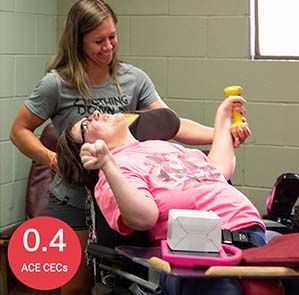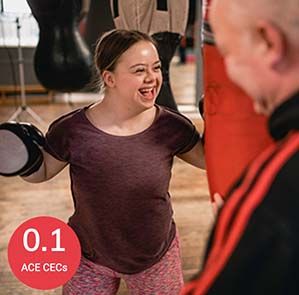
Working with any new client requires you to exercise your intuition, creativity, knowledge and understanding to accommodate their individual needs and to help them get results. These skills are even more important when working with clients who have cognitive delays or developmental challenges. Here are three common scenarios you might encounter when working with clients with cognitive impairments and how to best respond to reduce frustrations and anxiety to keep your sessions on track.
Cognitive Impairments: A Primer
Cognitive delays may include difficulties in speech, attention or focus compared to peers, a lack of understanding of rules and consequences, and difficulties in motor skills. Common diagnoses include attention-deficit/hyperactivity disorder (ADHD), autism spectrum disorder, Down syndrome, dyslexia, aphasia, and/or brain injury. It is currently estimated that one in six children have some type of developmental disability.
It is not uncommon for a person with cognitive delays to find it difficult to transition through activities, causing them to experience frustration and sensory overload. The resulting behaviors are most often triggered by emotions of anxiety, panic, discouragement and/or fear.
As a health and exercise professional, it is essential that you take the time to thoroughly understand the triggers, behaviors and specific features of a client’s cognitive delay before beginning their training sessions. Potential triggers and behaviors should be addressed in the initial interview with both the client and their caretaker or guardian. It is important to be thorough in asking questions about fears and anxieties relating to a wide range of factors, such as sounds, certain dates of the year, people, or staff or medication changes, all of which can profoundly affect the quality of your training sessions.
In addition to being well-prepared, it’s important to also become highly observant of changes in a client’s demeanor that may signal that they may be getting frustrated or overwhelmed. Understanding a client’s body language and common mannerisms, which can often signal distress, can be helpful in anticipating and possibly diverting behaviors or struggles that can disrupt a training session. Clients who have cognitive delays may not be able to verbally communicate their frustrations as they are coming on, so you need to be able to recognize and sense this ahead of time, and revise your training plans, as needed.
“As a trainer, it is incredibly important to understand our clients’ needs and to know how to adjust sessions for ultimate success and benefit,” explains Courtney Holbrook, ACE Certified Personal Trainer and owner and lead trainer for ROAR Fitness, LLC. “Just like working with a neurotypical client, we want our clients [who have experienced cognitive delays] to be successful, safe and to experience the positive physical and mental benefits of exercising. Learning what triggers a client and how they typically respond to such triggers can change the whole client’s experience of a training session and help them create a positive association with exercise.”
With that in mind, here are three common scenarios you might encounter when working with clients who have cognitive delays and how to best respond to reduce frustrations and anxiety and keep your sessions on track.
Scenario 1: AVOIDANCE
People with developmental or cognitive delays typically struggle with sensory processing disorder. Sensory processing is defined as the organization of sensory information from the body and the external world that will allow a person to interact with their physical and social environments. When a person has disorganization of the sensory information in their brain, it leads to a cacophony of incoming data with no purpose or order, which can lead to outbursts, aggression, hiding, non-compliance, irritability, anger and frustration.
It is crucial that you understand the coping mechanisms a client may need to access to avoid these behaviors or, if the behavior is unavoidable, to learn how to negotiate or redirect behavior to something more positive.
Example: Imagine you walk into a training space for a workout session with a client. Instead of the client being ready to train, however, they have locked themselves in the bathroom and are refusing to come out. The parent or caretaker approaches you with their hands in the air and exclaims, “We can’t get them to come out. They don’t want to work out today, so I guess we will have to cancel. Sorry.”
At this point, you have two options:
1. Accept the cancelation and feel frustrated because this is an hour lost in your schedule and you could’ve used the time to catch up on paperwork you haven’t been able to get to this week.
OR…
2. Ask the caretaker or parent more questions to better understand the situation and how to respond. You also review your previous knowledge of this client’s triggers and make an intuitive decision about how to help the client participate in the session.
Something has triggered this behavior and knowing how to speak to the client will be the most important part of this approach. Your first goal should be to help the client feel safe from whatever they are afraid of or avoiding, and that starts with maintaining a calm demeanor. When you remain calm, the process of negotiation often works well in this situation. But first, allow the client to hear your voice and understand that you are there to help. Don’t ask too many questions, and instead allow long pauses during the conversation.
At this point, it can be helpful to tell the client about one or two aspects of the workout you have planned that you know they will enjoy and feel successful doing. Next, ask the client to come up with two things they want to do that can be completed at the end of the session. “If–then” statements work well. For example, “If we do this ________________, then we will do this __________.” Then, allow the client time to process the deal. When they come out of the bathroom, keep the workout short, to the point, and exactly as agreed upon with the “if-then” statement.
This method of negotiation is called a response strategy. The focus is on redirecting an avoidance behavior to a more productive, safe behavior. Doing so can help reduce the frequency of this avoidance battle in the future and increase the trust the client has for you, the trainer.
Scenario 2: OVERSTIMULATION
Learning to recognize body language prior to a workout session in a person with hypersensitivity will help you to know how to adapt that day’s programming to their specific needs on any given day. Typical overstimulating behaviors include:
- Speaking loudly or quickly
- Being aggressive or angry
- Acting or running around for no reason, or being restless
- Looking sleepy or worn out
Example: You have a training session with a client on a Friday. They have a new companion staff and they are scheduled to attend a family birthday party the next day. They come in with their head down, shuffling their feet, waving their hands and talking loudly. Their new staff looks up, raises their eyebrows while taking a deep breath and sits down to check-out mentally and emotionally. The client sits down on a piece of equipment and starts spinning out of control on the chair, forgetting the normal routine of the workout session.
As the health and exercise professional, you intuitively pick up on the excitement, anxiety and overstimulation of senses the client is experiencing inside their body. A weekend, a birthday party to look forward to and a change in staff can lead to behaviors like the ones your client is exhibiting, including outbursts, frustration and/or lack of focus. You will need to adjust the plans for the workout session and likely shorten the designated training time.
The next step is to remind the client of the normal routine of a workout session by writing it out on a board or a piece of paper to help them return their focus to the task at hand. Ask them to mark off each item as it is completed. It is also helpful to limit all other sensory input information as much as possible. For example, keep the lights dim and the variety of equipment textures and the number of distractions (such as other people, sounds and smells) to a minimum.
“There are many different ways a trainer can adjust their training session to help a client cope with being overstimulated or overwhelmed,” explains Holbrook. “Some of those options may include modifying your exercises, adjusting your reps and sets, taking a longer rest break, and sometimes even moving to a quieter location to train.”
Regardless of your original plans, the primary goal of the workout session is now to help your client cope with their feelings of overstimulation while safely and effectively being physically active.
Scenario 3: AN INABILITY TO FOCUS
Understanding that when a client with ADHD is hyperactive, impulsive and unable to focus, and not merely being disrespectful or careless, will save you many hours of frustration.
Example: You are leading a class that includes a small group of people who are ready to participate in a workout session together. While you are explaining the class plan, one student continuously moves around on the equipment behind the group, takes jabs and stabs at the kid standing in front of them, and keeps interrupting your instructions with comments. After releasing the group to set up the workout stations you just described, you see that the client continues to horse around and not follow directions. They repeatedly ask you what they are supposed to be doing next.
In this situation, you need to intuitively pick up on these behaviors and provide the client a role to play within the class. For example, the client could become the rep counter, leader, clock timer, person who writes the workout on the whiteboard, or anything else that would provide them with a purpose and reason to focus. This title or role should become the norm at every workout session to create normalcy and routine. These roles should be assigned with the expectation of boundaries, which should be written out, clarified and understood.
Final Thoughts
It is essential to note that there are times when a workout session needs to stop for the safety and well-being of the client or the health and exercise professional. Often, however, understanding the client’s needs, behaviors and triggers to behavior and how to address and manage these triggers can lead to a long-lasting relationship with great results for both you and your clients. Use the tools available to you, including the health-history form, a thorough interview with the client and their parent, guardian or caretaker, and an awareness of the client’s diagnoses, to better understand the client and their unique challenges and tendencies. In addition, the client will feed off your calmness and confidence during each session and will be more likely to mirror your demeanor.
Holbrook urges professionals not to be too rigid in their training methods. “Be flexible,” she urges. “You may not get through all your exercises you planned due to needing to take regulation breaks or you may need to change exercises altogether, and that is O.K. We need to learn how to adapt our programs and the use of our session to ensure the best training possible.”
Therefore, it is important to remain patient and understanding, speak slowly and allow long pauses as the client processes and calms down. Doing this, while also creating a safe, welcoming and non-overstimulating environment will lead to long-term success. As you gain your clients' trust, the likelihood of outbursts related to fear and the unknown should decrease, and more time can be spent training and having fun.
Expand Your Knowledge
 |
This course provides practical knowledge and tools that you can immediately begin using to positively impact the well-being of people with special needs—increasing their independence, improving their quality of life, enhancing their health profiles, and boosting their confidence. This course is heartfelt, client-focused and digs deep into understanding all aspects of how people with special needs think, feel, move, and function on all levels: both physically and emotionally.
|
 |
In this video training, you will learn how to lead a client with developmental and/or physical delays through a personal training or small group exercise session. You will discover creative and fun ways to engage and motivate clients in warm-ups, strength training and cardio workouts using various equipment, tools and communication methods.
|





 by
by 




